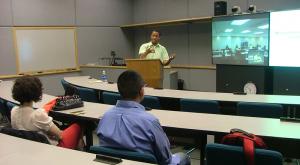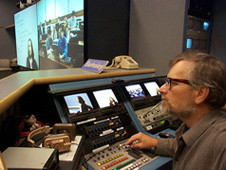Within and Beyond the Walls: Sustainability Implications of Educational Technology Infrastructure
Owen McGrath, University of California, Berkeley
Introduction
The New Auditorium
The Experimental Classroom
A Classroom Passed By
Beyond Walls
The campus setting of the second site presented in this chapter offers another technology sustainability riddle. While the previous example showed a technological race to catch up with the latest trend, the next example is a sobering reminder of how quickly educational technology fashion changes. The official narrative of the experimental classroom understandably focuses on the university’s effort to create an instructional space that supports Active Learning arrangements (Narum, 2004). A less publicized aspect of the project, however, involved the quiet shedding of a previous “next big thing” that had been occupying that same room: an expensive, high-touch, video teleconferencing classrooms for distance education.
 |
 |
Figure 4a and 4b: The once state-of-the-art video teleconferencing classroom in use. |
|
The term Active Learning covers a range of methods, including collaborative learning, problem-based learning, project-based learning, and more (Prince, 2004). The varied methods involved share an emphasis on bringing about more student engagement and participation than might typically be found in traditional classroom interaction patterns (Bonwell & Eison, 1991). Having recognized Active Learning as a promising new pedagogical movement emerging at peer institutions, university stakeholders agreed in 2011 to move forward and establish a pilot classroom in order to explore further. The initial goal of the local pilot initiative at the university, then, was to create a physically flexible, high-tech room for experimenting with the new mix of activities and interactions. Once operational, an important secondary goal of the room would be to offer, through observation and experience, the opportunity to identify desirable room features that could and should be implemented more widely throughout general assignment classrooms on campus.
After several months of designing and planning, the university’s educational technology services undertook the renovation of a video-teleconferencing classroom run by the educational services department. Once considered the way of the future, video-teleconferencing rooms provided a two-way audio and video connection that allowed two equally equipped facilities to connect electronically as one classroom (Niemeyer, 2003). Though this particular room saw some use over the years, the distance model it facilitated—virtually connecting classrooms together across campuses—never caught on at this university. Moreover, the high-priced technologies and service requirements of the room had been eclipsed in recent years by inexpensive, do-it-yourself web conferencing technologies on the Internet. The video teleconferencing classroom’s expensive, leased ISDN communication lines, analog cameras, and by-the-hour technical operator provisions were not in enough demand to recover costs.
 |
 |
Figure 5a and 5b: Demolition of the video teleconferencing classroom. |
|
To make way for Active Learning, the video teleconferencing room’s service would be discontinued. The room’s layout would need to go, too, though with some aspects of the physical infrastructure retained in an effort to re-use and recycle where possible. Acoustic paneling on three of the walls, fluorescent light fixtures, and the lighting control system were left in place. The light-blocking wall covering was taken down, allowing natural light to flow into the room for the first time in almost a decade. Still, as the demolition began, material removal exposed the many bundles of coils and cabling to be uprooted and thrown away. At each student seat, a small microphone stuck out of the bench top. The video teleconferencing room’s studio lighting system, raked seating, and curved bench tables concealed hundreds of feet of audio and video cable.  The custom-made, fixed benches and the stage and operator console areas were reduced to rubble and thrown in dumpsters, along with hundreds of feet of cabling and wires.
The custom-made, fixed benches and the stage and operator console areas were reduced to rubble and thrown in dumpsters, along with hundreds of feet of cabling and wires.
Figure 6: The experimental classroom includes mobile tables and chairs to allow for flexibility
Briefly reduced to a shell in the demolition phase, the room then underwent weeks of construction and installation in order to be re-outfitted for its new function. Opened in time for fall semester classes, the finished experimental classroom featured moveable and storable furniture. With a moveable podium for the instructor, the room was deliberately designed not to restrict instructors to a single location from which to teach. Today, the room also has an impressive collection of A/V-IT furnishing, including four large LCD monitors, ceiling-mounted microphones, and wireless control of the A/V system via an unmounted tablet. The LCD monitors can display the same image or four different images independently, a feature deemed useful for students taking turns giving presentations. In addition, the room can still accommodate classroom video conferencing, using programs such as Skype on a fast network connection to the instructor computer.
Once classes were underway, it soon became apparent that instructors and students differed in their perspectives on the computer presentation technologies. Attracted to the room initially by the flexibility of the physical environment, most of the instructors using it during the first year found the A/V-IT somewhat daunting.
Figure 7: The interface for the experimental classroom’s AV functions includes laptop display options, lighting, and volume controls.
They required one-on-one training and assistance from department support staff. In contrast, the students were somewhat blasé about the technology they found in the room. Their responses in interviews and surveys centered mainly on the unusually nice aesthetics of the room, although they did approvingly note its extra available AC power outlets.
Interestingly, the one feature of the new room that both instructors and students would laud unanimously was not high tech at all. The many surveys and interviews of users across the first year confirmed the anecdotal evidence that emerged almost within a day of the room’s opening: the set of portable whiteboards in the room were seen by all as a key enabling feature of the new active learning arrangements. As often happens in educational technology deployments, the experimental classroom users had embraced features of the environment and tools in unanticipated ways. Students used the portable white boards in nearly all of the classes observed in the first semester. Uses of the lightweight boards varied from putting up personal reflections to reporting out small group discussions. Discussions among multiple students usually took place in small groups, either gathered at the boards hanging up or using the boards lying flat on the tables.
From a sustainability perspective, the observed technology trajectory of the room over time can seem almost incidental to the renovation effort involved. A video teleconferencing room is demolished to make way for a sophisticated, state-of-the-art A/V-IT infrastructure. In the end, the wonderful affordances provided by the system –- multiple video displays, video and animation playback, live video conferencing with remote guest lecturers--were somewhat taken for granted by the students. Although the technology saw frequent use, it got very little recognition from the students who were interviewed or surveyed. The media presentation and control systems installed in the new classroom were not viewed as being particularly innovative or exciting. The large plastic tablets for use with dry erase markers were the novelties that got attention and won their praise. For a generation of students who grew up accustomed to personal computers and home entertainment systems, there apparently wasn’t anything unusual about having multiple, shareable LCD displays around the room. For them, what did provide novelty and some wow factor were the simple portable writing surfaces around which they could gather and collaborate physically.

